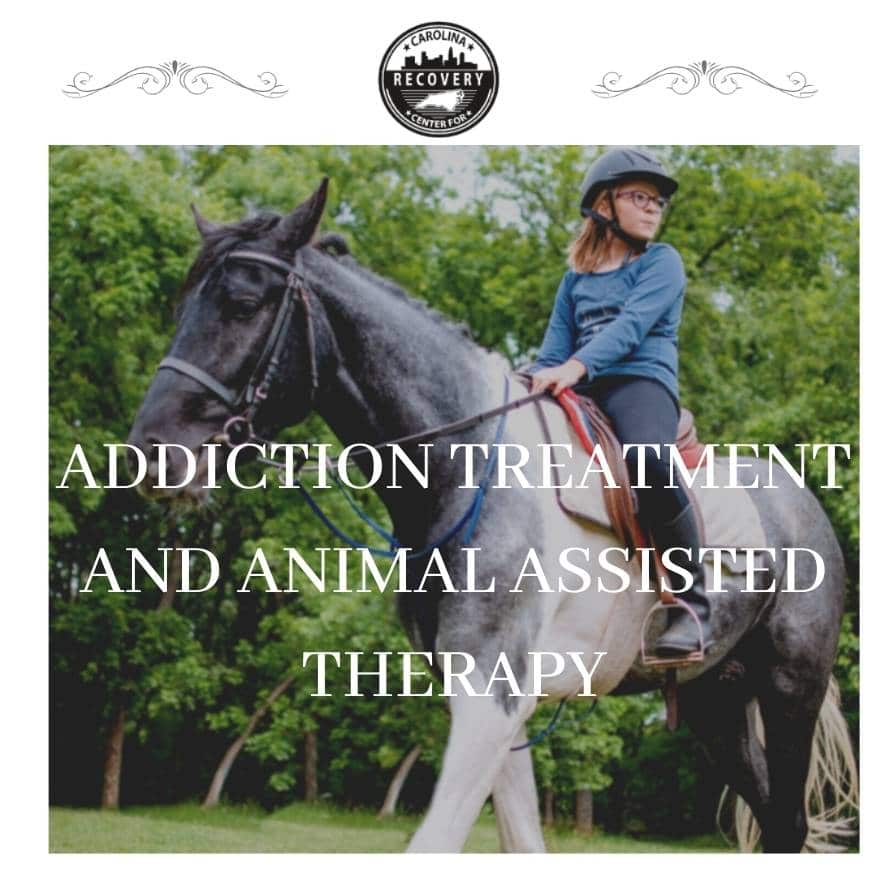“Animal-Assisted Therapy in Addiction …” from carolinacenterforrecovery.com and used with no modifications.
Key Takeaways
Animal-assisted therapy (AAT) involves the use of animals to improve emotional and psychological well-being, especially in substance use disorder (SUD) treatment.
Common animals used in therapy include dogs, cats, horses, and even dolphins, each providing unique benefits.
AAT can significantly reduce anxiety and stress, improving the overall therapeutic environment for individuals with SUD.
This therapy enhances social interactions and helps build trust between patients and therapists, which is crucial for recovery.
Incorporating AAT into traditional treatment programs can offer a holistic approach, improving outcomes and patient satisfaction.
Animal-Assisted Therapy for Substance Use Disorder Explained
Animal-assisted therapy is a unique approach that leverages the natural bond between humans and animals to facilitate healing and recovery. It’s especially useful in the context of substance use disorders, where traditional therapy methods sometimes fall short. By introducing animals into the therapeutic environment, we can create a more relaxed and supportive atmosphere that encourages openness and healing.
Defining Animal-Assisted Therapy
Animal-assisted therapy is more than just spending time with animals. It’s a structured intervention that involves trained animals and handlers working alongside therapists to achieve specific therapeutic goals. These goals can include reducing stress, improving social skills, or enhancing emotional regulation. By integrating animals into therapy sessions, we tap into the innate comfort and joy they provide, which can be particularly beneficial for those battling substance use disorders.
Types of Animals Used in Therapy
Different animals bring different benefits to therapy sessions. Dogs are perhaps the most common, known for their loyalty and ability to sense human emotions. Horses are also popular in what’s known as equine-assisted therapy, offering opportunities for building trust and improving self-esteem. Cats, birds, and even dolphins are used in various settings, each providing unique interactions that can aid in recovery.
Benefits of Animal-Assisted Therapy in Addiction Treatment
Animal-assisted therapy offers numerous benefits for individuals dealing with substance use disorders. One of the most significant is the emotional and psychological support it provides. Interacting with animals can help individuals feel more at ease, reducing the emotional barriers that often hinder progress in traditional therapy. To learn more about how this approach aids in addiction recovery, visit Southern Sky Recovery.
Emotional and Psychological Support
Animals have a remarkable ability to provide unconditional love and acceptance, which can be incredibly healing for those struggling with addiction. This non-judgmental presence helps individuals open up about their experiences and feelings, fostering a deeper connection with their therapist. Moreover, the act of caring for an animal can instill a sense of responsibility and purpose, motivating individuals to pursue their recovery goals.
Reducing Anxiety and Stress
One of the most immediate benefits of animal-assisted therapy is its ability to reduce anxiety and stress. Animals can have a calming effect, lowering heart rates and promoting relaxation. This is crucial for individuals with substance use disorders, who often experience heightened levels of stress and anxiety. By providing a soothing presence, therapy animals help create a more conducive environment for healing.
“Interacting with therapy animals can significantly reduce stress levels, making it easier for individuals to engage in their treatment programs.”
Imagine walking into a therapy session and being greeted by a friendly dog wagging its tail. This simple interaction can instantly change the atmosphere, making it more welcoming and less intimidating. Such experiences can greatly enhance the effectiveness of therapy sessions, encouraging individuals to participate more fully in their recovery journey.
Examples of Animal-Assisted Therapy in Practice
Animal-assisted therapy is increasingly being adopted in various settings to support individuals with substance use disorders. Each practice incorporates different animals, offering unique therapeutic experiences that cater to the diverse needs of individuals on their recovery journey.
By integrating animals into therapeutic settings, we can create environments that are not only supportive but also deeply transformative. These examples illustrate the practical applications of animal-assisted therapy and highlight its impact on recovery outcomes.
Case Study: Canine Therapy in Rehabilitation Centers
In many rehabilitation centers, canine therapy has become a cornerstone of treatment programs. Dogs, with their intuitive nature and affectionate demeanor, play a crucial role in helping individuals feel comfortable and secure. A study conducted in a rehabilitation center found that participants who engaged with therapy dogs reported lower levels of anxiety and higher levels of motivation to complete their treatment programs.
One patient shared how the presence of a therapy dog named Max helped him through challenging therapy sessions. “Whenever I felt overwhelmed, Max would come and sit by me, and it was like he understood what I was going through. It made it easier to open up and talk about my struggles,” he explained.
Equine Therapy for Young Adults with SUD
Equine therapy is another powerful example of animal-assisted therapy in practice. Horses are known for their sensitivity and ability to mirror human emotions, making them ideal partners in therapy. For young adults with substance use disorders, equine therapy offers opportunities to build trust, improve communication skills, and develop a sense of responsibility.
One program designed for young adults involves participants working closely with horses, learning to care for them and engage in activities like grooming and riding. This hands-on approach fosters a sense of accomplishment and boosts self-esteem, which are critical components of recovery.
Participants often describe equine therapy as a life-changing experience. One young adult remarked, “Working with the horses taught me patience and how to trust again. It was a big step in my recovery process.”
Incorporating Therapy Animals in Group Sessions
Group therapy sessions can be daunting for many individuals, especially those with social anxiety or trust issues. Incorporating therapy animals into these sessions can make a significant difference. Animals help break the ice, creating a more relaxed and open atmosphere that encourages participation and honest communication.
In one group therapy setting, a therapy dog named Bella played a pivotal role in facilitating discussions. Her presence helped participants feel more at ease, leading to more productive sessions. Therapists noted that Bella’s ability to sense tension and provide comfort at the right moments enhanced the overall therapeutic experience.
Implementing Animal-Assisted Therapy in Treatment Programs
Introducing animal-assisted therapy into treatment programs requires careful planning and consideration. It’s essential to understand the unique needs of each individual and how different animals can support their recovery journey. By following structured steps and guidelines, treatment centers can effectively integrate therapy animals into their programs, enhancing the overall therapeutic experience.
Steps for Integrating Therapy Animals
Identify the specific needs and goals of the treatment program.
Select appropriate animals based on their temperament and suitability for therapy work.
Ensure that both the animals and handlers are adequately trained and certified.
Design therapy sessions that incorporate animal interactions in a way that aligns with therapeutic objectives.
Continuously evaluate and adjust the program to ensure it meets the needs of participants.
Guidelines for Safe and Effective Sessions
Safety is paramount when incorporating animals into therapy sessions. It’s crucial to establish guidelines that protect both participants and animals, ensuring a positive experience for everyone involved. Here are some key guidelines to follow:
For more information on how animal-assisted therapy can benefit addiction and mental health treatment, explore additional resources available.
Conduct thorough assessments of participants to determine their suitability for animal-assisted therapy.
Maintain a clean and safe environment for therapy sessions.
Monitor interactions closely to prevent any potential risks or discomfort for participants or animals.
Provide clear instructions and support to participants on how to interact with therapy animals.
Ensure that animals are well-cared for and receive regular health check-ups.
Training Requirements for Therapy Animals
Therapy animals must undergo specialized training to prepare them for their roles in therapeutic settings. This training focuses on developing the animal’s ability to remain calm and responsive in various situations, ensuring they can provide the necessary support during therapy sessions.
Training programs typically include socialization exercises, obedience training, and exposure to different environments and stimuli. Additionally, handlers must be trained to understand animal behavior and manage interactions effectively, ensuring a safe and supportive experience for all participants.
By investing in comprehensive training for therapy animals and their handlers, treatment programs can maximize the benefits of animal-assisted therapy, providing individuals with a powerful tool in their journey toward recovery.
Comparing Traditional and Animal-Assisted Therapies
When evaluating therapeutic approaches for substance use disorders, it’s essential to understand how traditional therapies compare with animal-assisted therapy. Traditional therapies, such as cognitive-behavioral therapy (CBT) and group counseling, focus on identifying and changing negative thought patterns and behaviors. These methods are evidence-based and widely used in treatment settings. However, they can sometimes feel impersonal or challenging for individuals who struggle to open up in conventional settings.
Animal-assisted therapy introduces a unique dynamic that can complement these traditional methods. By incorporating animals into therapy, we create a more engaging and supportive environment that encourages individuals to participate more fully in their treatment. The presence of animals can reduce barriers to communication, making it easier for individuals to express themselves and connect with their therapist.
Advantages of Including Animals in Therapy
One of the primary advantages of animal-assisted therapy is its ability to create a sense of comfort and safety. Animals provide non-judgmental companionship, which can help individuals feel more at ease during therapy sessions. This comfort can lead to increased engagement and willingness to participate in therapeutic activities.
Moreover, animals can serve as a bridge in building trust between the therapist and the individual. This trust is crucial for successful therapy outcomes, as it allows for more honest and open communication. Additionally, the presence of animals can reduce stress and anxiety, which are common barriers to effective therapy.
Limitations and Considerations
While animal-assisted therapy offers numerous benefits, it’s essential to recognize its limitations. Not all individuals may feel comfortable around animals, and some may have allergies or phobias that prevent them from participating. Therefore, it’s crucial to assess each individual’s suitability for animal-assisted therapy before incorporating it into their treatment plan.
Another consideration is the availability of trained therapy animals and handlers. Implementing animal-assisted therapy requires resources and expertise to ensure that sessions are conducted safely and effectively. It’s essential to have trained professionals who can manage the interactions between participants and animals, ensuring a positive experience for all involved.
Despite these considerations, animal-assisted therapy remains a valuable tool in the treatment of substance use disorders. By understanding its advantages and limitations, we can make informed decisions about how best to integrate this approach into comprehensive treatment programs.
Frequently Asked Questions
As animal-assisted therapy gains popularity, many people have questions about its implementation and effectiveness. Here are some common questions and answers to provide clarity on this therapeutic approach.
What types of animals are commonly used in animal-assisted therapy?
Animal-assisted therapy can involve a variety of animals, each offering unique benefits. Commonly used animals include dogs, known for their empathy and ability to sense human emotions, and horses, which are popular in equine therapy for their calming presence and capacity to build trust. Cats, birds, and even smaller animals like rabbits can also be used, depending on the therapeutic goals and individual preferences.
How do animals aid in the treatment of substance use disorders?
Animals play a significant role in the treatment of substance use disorders by providing emotional support and reducing stress and anxiety. Their presence can make therapy sessions more comfortable and less intimidating, encouraging individuals to open up and engage more fully. Additionally, caring for an animal can instill a sense of responsibility and purpose, motivating individuals to pursue their recovery goals.
Are there any risks associated with animal-assisted therapy?
While animal-assisted therapy is generally safe, there are some risks to consider. These include potential allergies or phobias related to animals, which can make therapy sessions uncomfortable for some individuals. It’s essential to conduct thorough assessments to ensure that participants are suitable for this type of therapy. Additionally, it’s crucial to have trained professionals overseeing sessions to prevent any potential issues or discomfort for both participants and animals.






